-
Posts
2,284 -
Joined
-
Last visited
-
Days Won
6
Content Type
Profiles
Forums
Blogs
Gallery
Events
Store
Posts posted by PKeating
-
-
Titties? Oh...I see!
P
0 -
I'll allow gliders!
PK

 0
0 -
'Fraid so, John! LOL! If it's any consolation, guys, it took me a while to work it out!
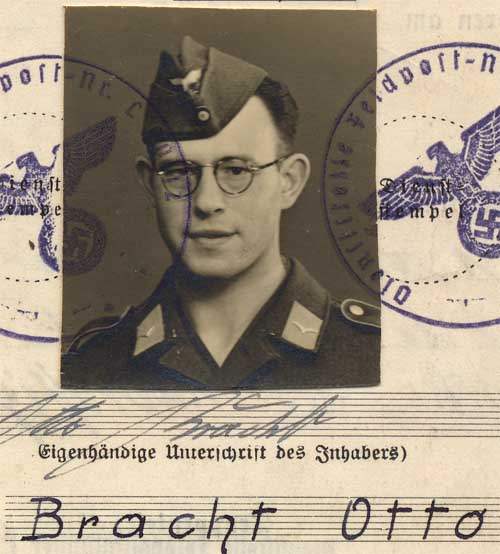
 0
0 -
Getting warmer but there's still an icicle on your nose...
Hoch in die Lufte schwebt unser Vogel...
Here's a photo of Otto Bracht, which I found by chance in the ECPA-D archives in Fort d'Ivry.
PK
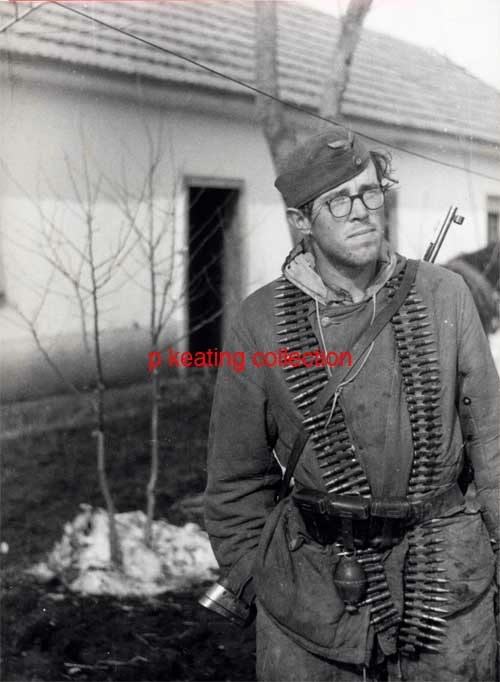
 0
0 -
Stijn David is excluded from this quiz because he knows the answer! So, where did Otto Bracht earn the EK2 and what do you think he was doing, or had been doing, when he was recommended for it?
PK

 0
0 -
Walter Barth's French vaccinations are interesting given that he appears to have been a prisoner of the British.

 0
0 -
Not at all, Chris! Cloth badges were, as we know, unofficial tailorshop items tolerated by the authorities. In the case of the FSA, it was 'officialised' by the authorities as a morale-boosting interim measure to give newly-trained paratroopers something to show for their efforts when they graduated from jump school. Many young paras were being posted to frontline units and getting killed before their award documents and issue badges caught up with them, a process that could take weeks or even months if a unit was moving around a lot. So the OKL introduced these award documents and gave out cloth badges with them. Below is a photograph of another Class of '44 paratrooper, photographed on leave in Germany just after graduating from jump school in Serbia. Walter Hummel is wearing the cloth version of the Luftwaffe badge on his tunic.
PK
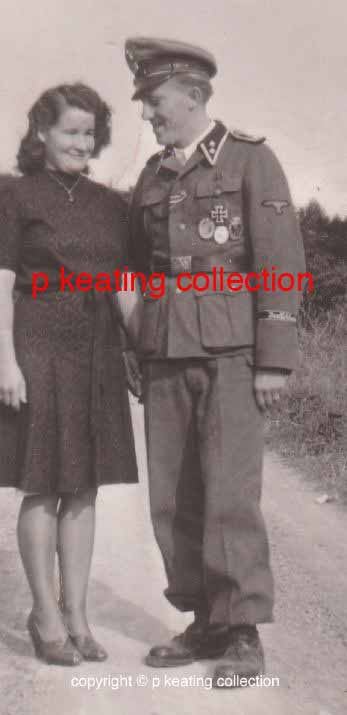
 0
0 -
His PoW card, clearly filled out by a British or an American hand.

 0
0 -
He survived the war but died relatively young. Here's an interesting little chit charting his vaccinations as a PoW. So at one point, Walter Barth seems to have been a guest of the French. There again, perhaps he and his fellow Prisoners of War were merely taken to a French camp for their vaccinations. The Ricketts jab is quite telling, isn't it? He was discharged in 1948 by the British.
PK
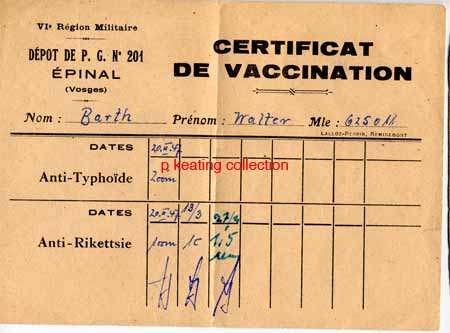
 0
0 -
There are about sixty photos with his papers, mostly related to his Flak-Artillerie service. The only FJ-related photo is of an NCO with whom he served. He and his comrades clearly had neither the time nor inclination to take snapshots during and after the Normandy battles. There are some rather touching family photos, showing uncles and cousins in uniform, as well as BDM photos and an interesting Marine-HJ portrait from 1934. Anyway, there you have it: the life and death of a Son of the Fatherland.
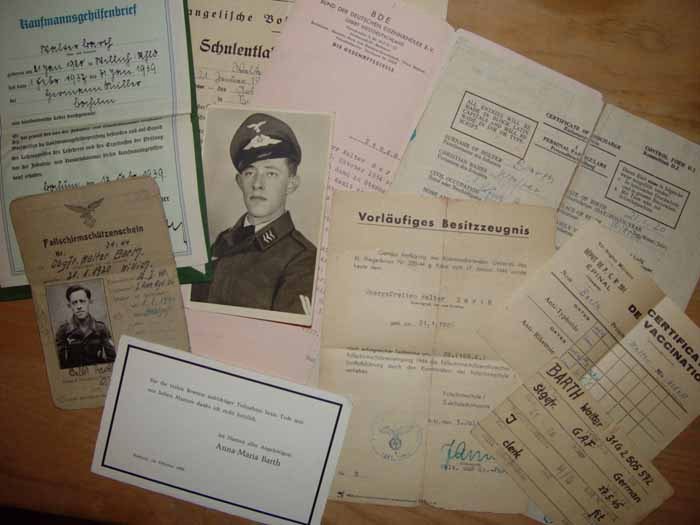
 0
0 -
He was just forty-four years old when he died.
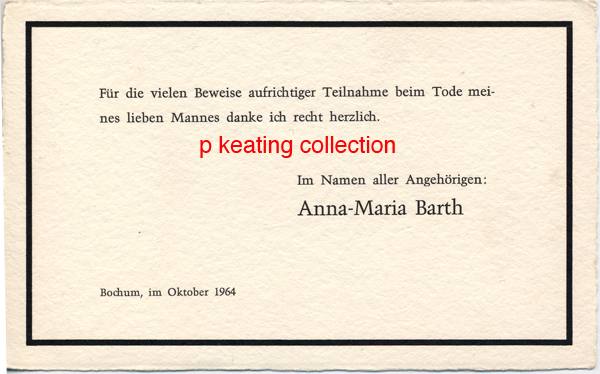
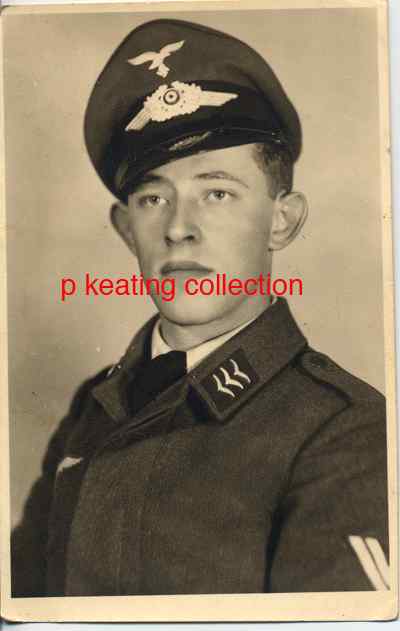

 0
0 -
Fallschirm-Sanit?ts-Abteilung 5 was part of 5. Fallschirmj?ger-Division, formed in Reims in March and April 1943 under the command of Generalleutnant Gustav Wilke, who would command the division until September 1944. 5. FJD was formed with III./FJR3, III./FJR4, the Fallschirm-Lehr-Bataillon as cadre and fresh recruits from various branches of the Luftwaffe, like Walter Barth.
Finishing his parachute training at Dreux early in July 1944, it is reasonable to presume that Walter Barth transferred from the Flak at least six months previously so he would have been at Reims and then, perhaps, briefly in Brittany, the division having been posted to the Rennes area in May 1944, before he went to Fallschirmschule 1. As FJ historians and students know, the division was far from combat-ready on 6.6.1944 but was thrown into the fighting all the same, suffering very heavy losses. Look again at Walter Barth's face and compare this prematurely aged 24 year old to the smiling youngster with his mates in the Flak-Artillerie.
Walter Barth survived Normandy and the retreat and was evidently with 5. FJD when it reformed around Amsterdam and The Hague in October and November 1944. The division fought in the Ardennes, the Harz Mountains and the Ruhr Pocket. The majority of the division surrendered at the N?rnburgring in March 1945, after the death of the divisional commander Ludwig Heilmann, who had taken over from Wilke in September 1944. The remaining Fallschirmj?ger of 5.FJD fought on under their new, nominal commander, Oberst Gr?schke before surrendering in the Ruhrkessel, with remaining elements going into the bag as the Allies rolled through the Harz Mountains.
0 -
The very, very rare late war cardboard FSS issued to Walter Barth, who would have been one of the last para-trained Fallschirmj?ger of WW2. By late July 1944, parachute training had been indefinitely suspended at all the schools in France (obviously!), Germany and Hungary. Walter Barth probably lost his soldbuch and other documents during the retreat from France as his FSS appears to have served as an ID document on which his promotion to Stabsgefreiter in January 1945 was recorded. Note also the entry for July 1945, closing off the document. This was when Barth and his surviving comrades from the rebuilt 5.FJD went into the bag.
PK
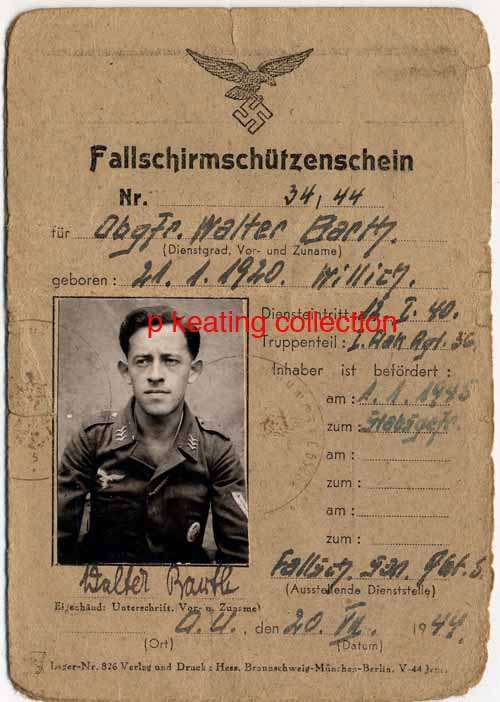


 0
0 -
And here is how Walter Barth looked on 20.7.1944, after less than two weeks in Normandy with Fallschirm-Sanit?ts-Abt 5, where the Fallschirmsch?tzenschein (Parachutist Licence) was issued to him. Note the padded cloth badge he received in Dreux on 5.7.1944.
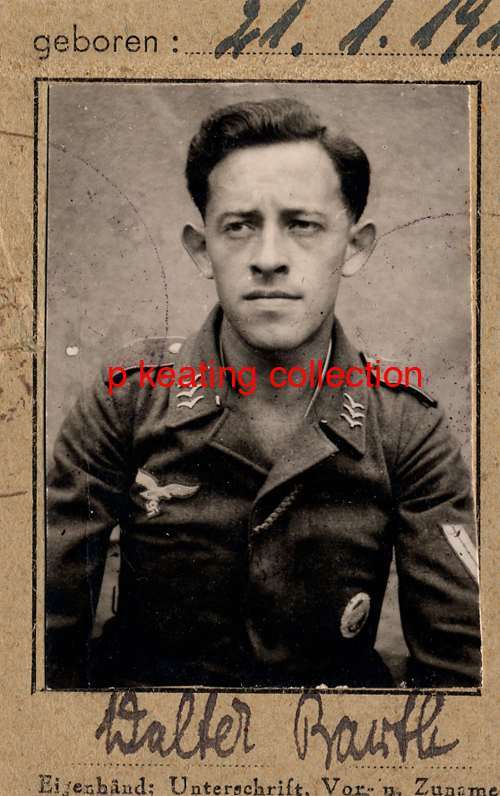
 0
0 -
Walter Barth was born on 21.1.1920. He did very well at school and was apprenticed at fourteen. Prior to joining the Fallschirmj?ger, he served with a heavy Flak unit in various places, including France. He was stationed at Le Bourget aerodrome on the north-western outskirts of Paris at one point. Here is a fresh-faced Walter with some of his mates.
PK
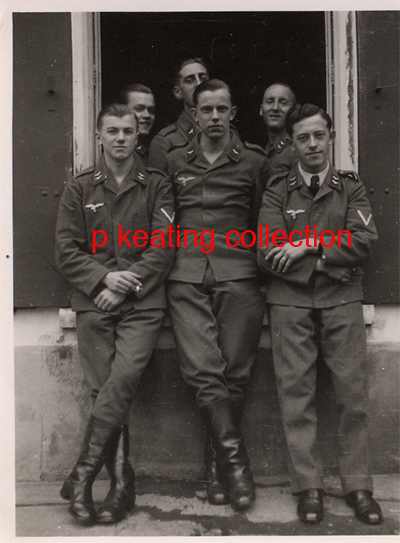
 0
0 -
You don't see these very often. Walter Barth and his mates must have able to hear the Allied guns as they completed their jump course at Dreux, to the west of Paris, in July 1944.
There was another type of document for the Parachutists Badge in cloth, incorporating a counterfold - in other words, a folded A4 sheet - with an artist's portrait of the F?hrer. I am reliably informed that these were carefully removed by recipients and put to the appropriate use during morning ablutions. This is the simple A5 document.
PK
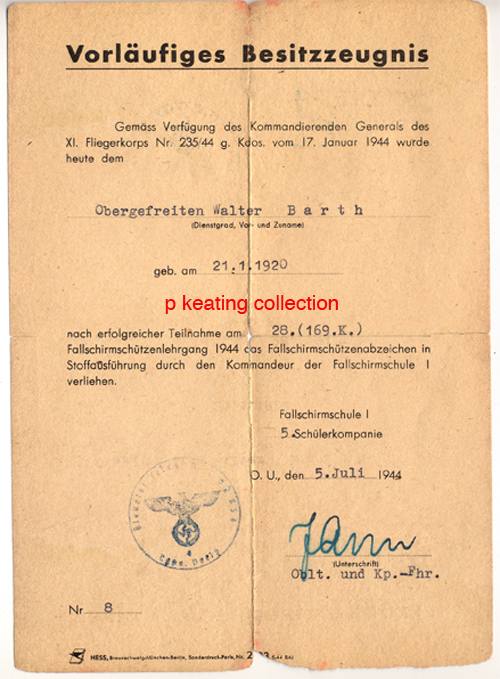
 0
0 -
A close-up. Now, is it just a trick of the camera or are those collar patches blue, as worn by medics? The fellow who had this photo served with an 88mm Flak-Artillerie unit before transferring to the 5. Fallschirmj?ger-Division as a medic, where he presumably received this photograph as a souvenir from, obviously, the man pictured therein.
PK
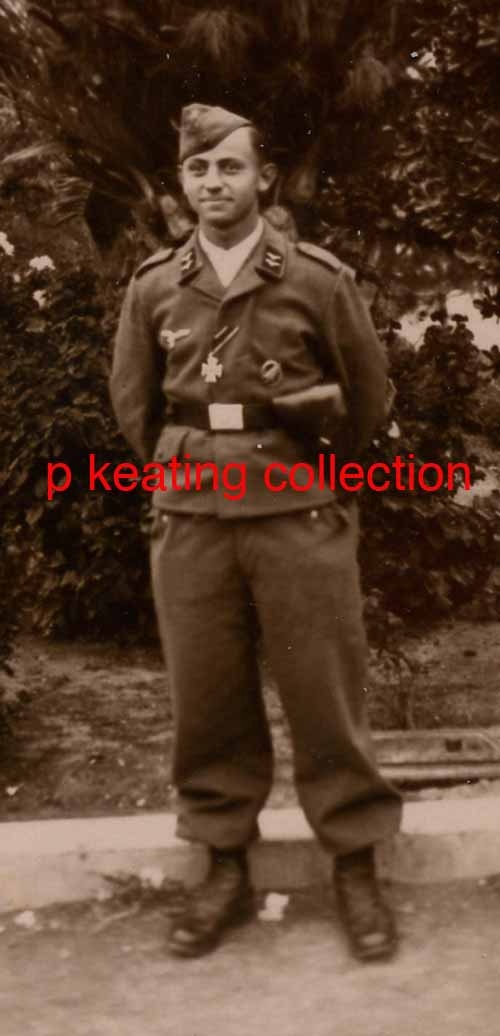
 0
0 -
Here's the front. It's a very nice snapshot of a proud Korinthspringer just after receiving his EK2 for the canal jump. Crete was yet to come...
I rather like the way the original print or negative appears to have been deformed at some point before this NCO made up these postcard version, presumably to give to family and friends, like the man from whose group this came.
PK
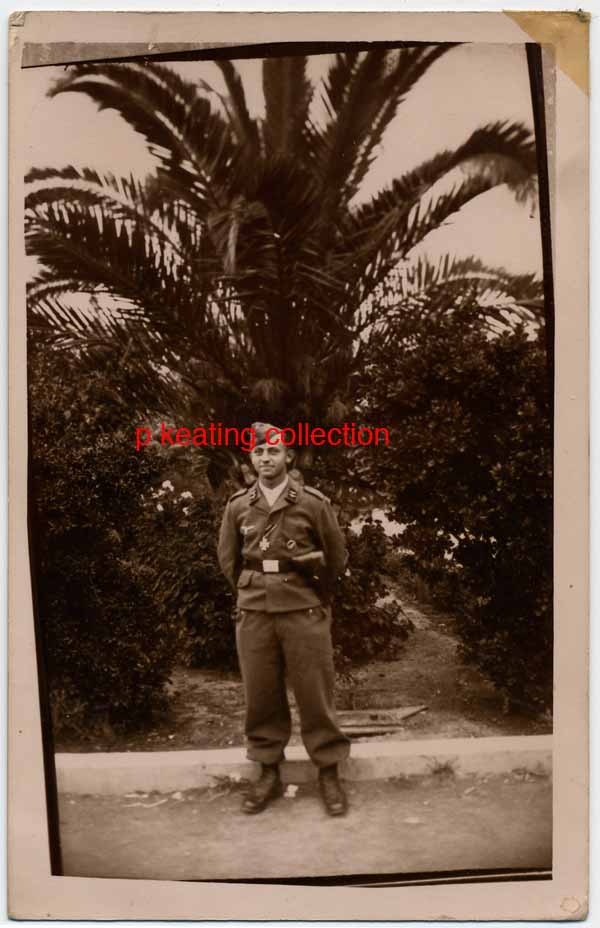
 0
0 -
I'm having trouble deciphering the name on the back of this photo from the collection of a Flak-Artillerie man who became an FJ medic in 1944.
PK
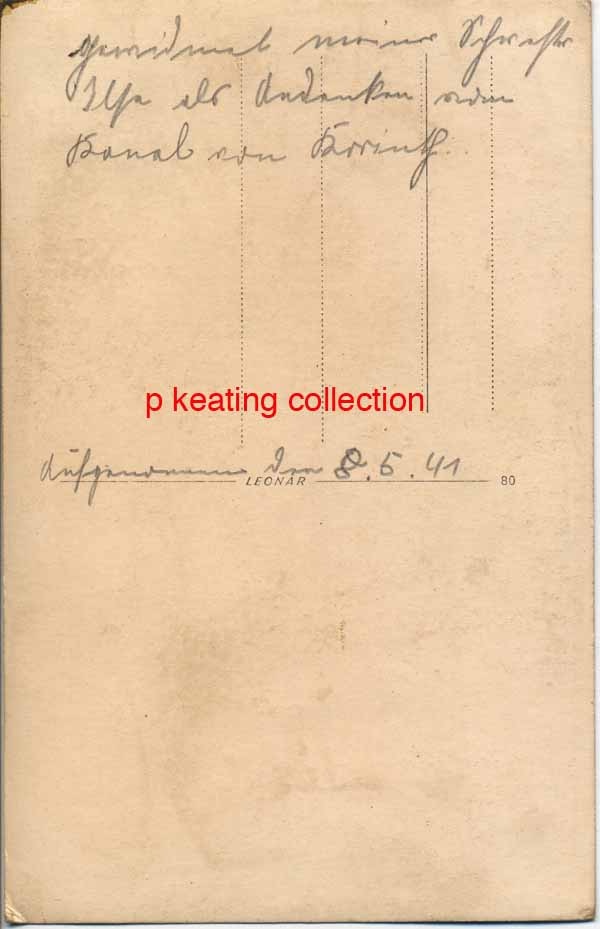
 0
0 -
Incidentally, the above Type 2b badge is for sale. See "Original Genuine Sales" elsewhere on this website. It is not advertised anywhere else.
PK
0 -
Tasty docs, Simon! Yes, I remember that Heitkamp EK2 document. 13./LLSR landed just south of Maleme aerodrome. They also fought in Canea. The chap to ask would be Jean-Yves Nasse.
PK
0 -
And here is an original Type 2 FSA (Heer). This is the Type 2b with the thicker wreath but struck on the same dies as the Type 2a and, incidentally, the 1943/1944 badges in feinzink.
PK

 0
0 -
Here is another of these fakes, offered as original by a British dealer, side by side with a genuine 1957-pattern badge. The diving eagles are, as you can see, similar though not identical. The comparison supports the contention that the diving eagles on the type of fake in question were sourced from a firm producing 1957-pattern badges. This image came from an article by the dealer in question and I am posting it here under Fair Use provisions.
PK
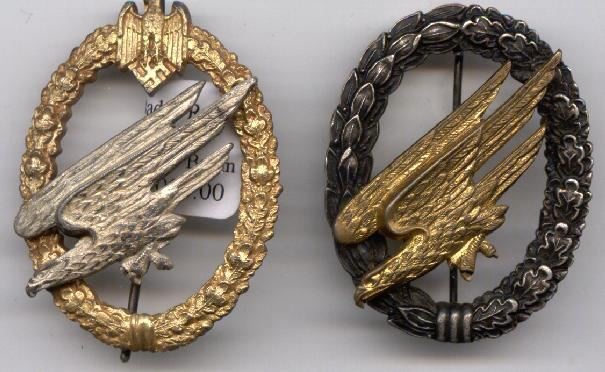
 0
0 -
I am afraid that this is a type of fake first seen in the late 1960s and still offered as original by some dealers. These have caught a lot of people out. Some Type 2 aluminium Army Para Badges bore C E Juncker's stamp on the reverse of the diving eagle but it was quite different to this stamp, which is more like the stamp seen on some wartime Luftwaffe badges. Here's an extract from an article I wrote a while ago:
Note the ?ghostbusters? or ?Caspar the Friendly Ghost? silhouette of the Wehrmacht eagle when viewed from the back. Other points to note include the Question Mark hook rather than the correct C form hook and the odd-looking gold finish applied over some kind of black primer, used presumably to fill in the blowholes in the cast aluminium wreath, which is not even cast from an original. These fakes are usually but not always marked with a fake and incorrect mid-war C E Juncker hallmark when, in fact, only three Juncker-marked Type 2 badges are known to exist. They have caught out many collectors and continue to be offered as original by dealers.The diving eagles appear to be well struck and are probably from a stock of 1957-pattern denazified Fallschirmsch?tzdenabzeichen but the wreaths are, as I said, cast. Have a look at how this fake compares to a known, original Type 2 aluminium badge.
PK
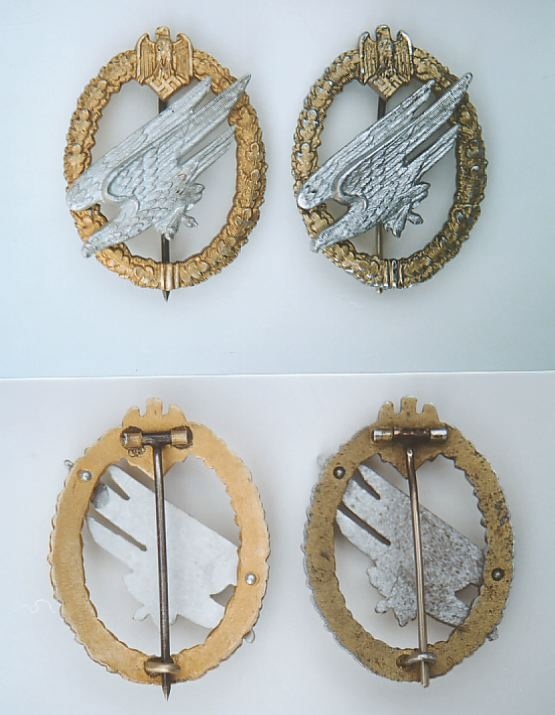
 0
0




Quiztime: Otto Bracht's Iron Cross 2nd Class
in Germany: Third Reich: Research, Documentation & Photographs
Posted
That's what I thought. And it's possible. But he would have to have been seconded to another transport squadron for R?sselsprung. Which is entirely possible given the need for glider pilots for the Tito operation. However, I am not sure that the EK2 document would have come from the Fallschirm-Armee Oberkommando in that case.
Otto Bracht flew gliders for sport before and after WW2: http://lsg-lippe.de/htm/ve_gesch.htm
PK